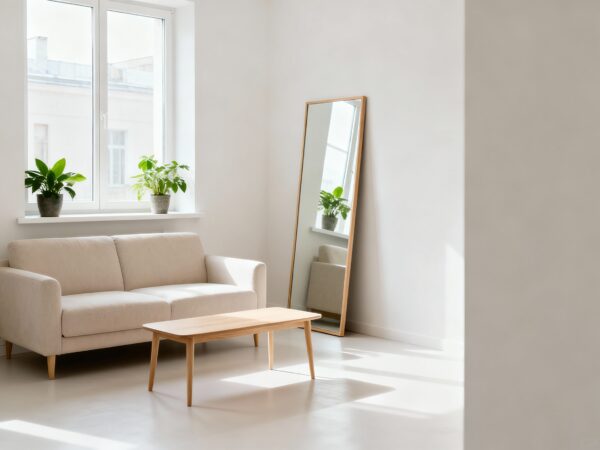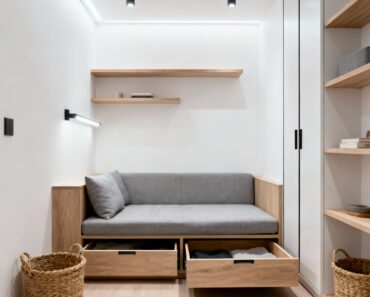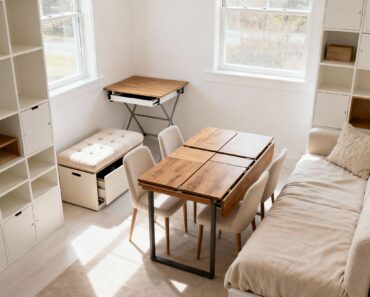There’s something incredibly satisfying about walking into a home that feels airy, open, and uncluttered. Yet for many people living in small apartments or compact houses, space can feel like a luxury. The good news? You don’t need to move or renovate to make your home feel larger. With a few clever adjustments, you can open up even the tiniest space using light, layout, and a touch of creative thinking.
Let’s dive into the easiest ways to visually and functionally expand your living area without spending a fortune or picking up a paintbrush every weekend.
1. Start with Visual Lightness
One of the simplest ways to make a small room feel bigger is to let it breathe visually. Light colors naturally reflect more light, which helps create an illusion of space.
-
Choose pale neutrals for walls—soft whites, creams, or muted grays. These shades act like mirrors, bouncing light across the room.
-
Keep your curtains sheer or use blinds that can easily draw up and disappear. Heavy drapes, while cozy, close in the space.
-
Add a few mirrors strategically across from windows to amplify sunlight and enhance brightness.
Even replacing dark furniture with something lighter or glass-topped can shift the whole mood. The clearer your visual lines are, the bigger your space will seem.
2. Clear the Visual Clutter
Nothing shrinks a room faster than clutter. Small spaces demand simplicity, but that doesn’t mean sterile minimalism. It means thoughtful editing.
Take a weekend to declutter with intention:
-
Remove duplicate or unused decor pieces.
-
Keep surfaces as clear as possible, adding only a few statement accents.
-
Choose furniture that hides storage—ottomans, coffee tables with drawers, benches with compartments.
When everything has a place, even a tiny living room can feel calm, open, and inviting. Remember: blank space isn’t wasted space—it gives the eye room to rest.
3. Let There Be Layers of Light
Overhead lighting alone rarely does a small room justice. Layering your lighting creates depth and warmth that tricks the eye into seeing more dimension.
Blend ambient, task, and accent lighting:
-
Use floor lamps to brighten dark corners.
-
Add wall sconces in tight areas where floor space is limited.
-
Place small table lamps or strip lights under shelves to highlight features.
Soft, balanced lighting removes harsh shadows and helps corners visually recede, making your room appear more spacious.
4. Embrace Multi-Functional Furniture
When space is at a premium, every piece must pull its weight. Multi-functional furniture is the unsung hero of modern living.
Think beyond single-purpose items.
-
A sofa bed instantly transforms your living room into a guest area.
-
A folding dining table can expand for hosting but tuck away neatly afterward.
-
Nesting tables serve as surfaces when needed, then stack to save space.
Look for furniture that combines form and function—minimalist silhouettes, hidden storage, and neutral fabrics help keep everything cohesive.
5. Simplify the Color Palette
Too many competing colors can fragment a small space, making it feel chaotic. Stick with two to three main tones and vary their shades for visual depth.
A simple palette—say, beige, soft gray, and olive—creates harmony while allowing room for texture and pattern. Add character through materials instead of color clashes. Think woven rugs, linen throws, or wood accents that bring warmth and personality while keeping the space open.
This approach ensures cohesion, which visually stretches the perimeter of the room.
6. Use Vertical Thinking
If you can’t spread out, go up. Vertical space often goes underused, but it holds massive potential.
-
Install floating shelves above eye level to keep surfaces clear.
-
Hang curtains closer to the ceiling instead of above the window frame—this draws the eye up and instantly adds height.
-
Mount hooks or rails for everyday items like mugs, coats, or bags to free up precious floor room.
Vertical storage not only adds function but shifts how your mind perceives the room’s proportions.
7. Optimize Furniture Placement
Rearranging your furniture might sound simple, but it’s one of the easiest visual upgrades. Often, small rooms feel smaller because the layout blocks natural flow.
Here’s a little secret: don’t push every item up against the walls. Pulling furniture slightly forward creates a sense of depth. Even a few inches can make the room look airier.
Arrange seating areas to encourage better conversation flow, and leave pathways open. The goal is to direct the eye naturally around the space, not corner it.
8. Play with Reflective Surfaces
Glass, metal, mirrors, and glossy finishes all have one thing in common—they bounce light. Strategic use of reflective materials multiplies the sense of openness.
Think mirrored side tables, metallic lamp bases, or glossy paint on trim. Avoid overdoing it; one reflective piece per zone is often enough to lift the look. The more your surfaces interact with light, the softer and larger your home feels.
9. Create Zones Without Walls
Open layouts can quickly feel cluttered without clear definition, but physical barriers aren’t always the answer. You can create invisible “zones” using simple techniques:
-
Lay down an area rug to define a reading nook or living space.
-
Use furniture placement or lighting variation to subtly separate areas.
-
Choose consistent flooring throughout to keep flow seamless.
These gentle dividers make rooms feel intentionally designed rather than cramped or confused.
10. Add Greenery and Texture
Even in small spaces, nature has a way of refreshing the atmosphere. Plants draw the eye upward and bring life into corners that might otherwise feel static.
A tall indoor plant, a cluster of succulents on a shelf, or a hanging ivy can make all the difference. Choose vertical planters or wall-mounted greenery to save space.
Texture also matters—mix smooth ceramics, soft linens, and woven materials. When light and texture interact, your space feels layered, warm, and alive.
11. Keep What You Love
One easy trap when making small spaces feel bigger is removing too much personality. The goal isn’t to make your home look like a showroom—it’s to highlight what matters.
Select meaningful items—an art print, a handmade piece, or a cozy armchair—and let them shine. Personal touches prevent your minimalist approach from feeling sterile.
Your space should still reflect you. “Bigger” isn’t just about optics—it’s about emotional spaciousness too. A home that feels authentically yours always feels better, no matter the square footage.
Final Thoughts
Transforming a small space into something that feels larger isn’t about buying more or starting over. It’s about creating balance—between light and shade, simplicity and personality, openness and comfort.
By applying even a few of these adjustments—lightening colors, decluttering surfaces, and optimizing layout—you can completely change how your home feels. These are small shifts with big impact.
In the end, spaciousness is as much a mindset as a design goal. When your environment feels uncluttered, well-lit, and thoughtfully arranged, your mind feels clearer too. And that’s the real reward of designing your small space with intention.



